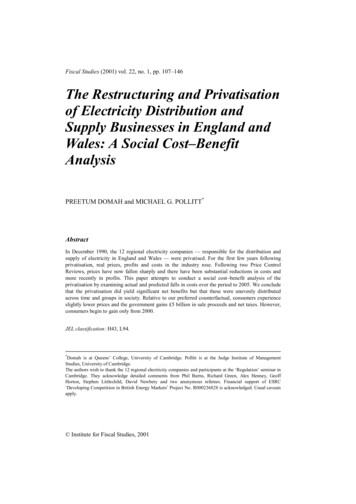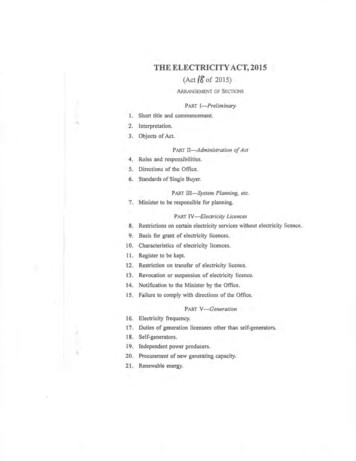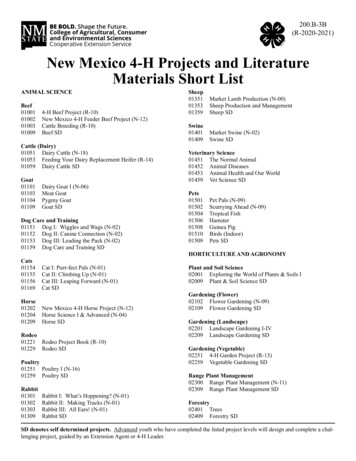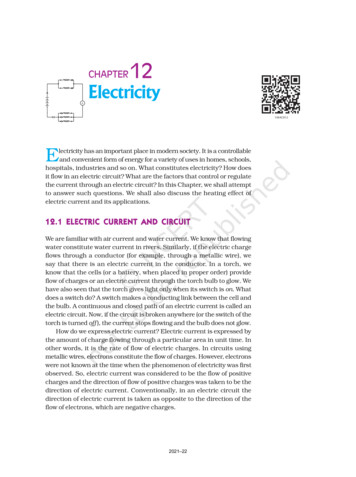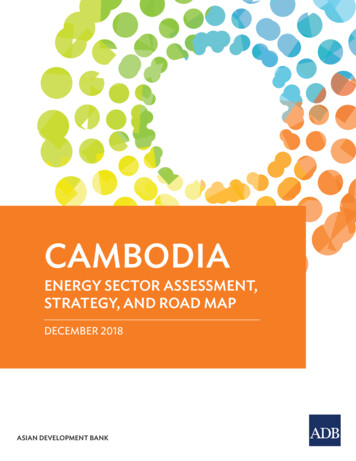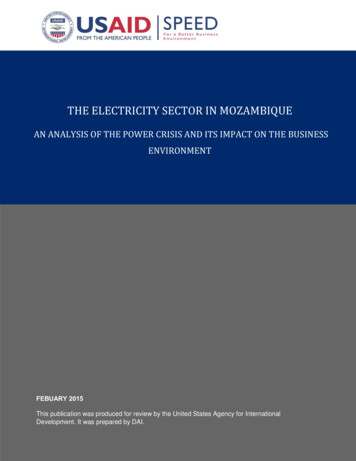
Transcription
THE ELECTRICITY SECTOR IN MOZAMBIQUEAN ANALYSIS OF THE POWER CRISIS AND ITS IMPACT ON THE BUSINESSENVIRONMENTFEBUARY 2015This publication was produced for review by the United States Agency for InternationalDevelopment. It was prepared by DAI.1
AN ANALYSIS OF THE POWERCRISIS AND ITS IMPACT ONTHE BUSINESS ENVIRONMENTFEBUARY 2015Program Title:Support Program for Economic andEnterprise Development(SPEED)Sponsoring USAID Office:USAID/MozambiqueContract Number:EDH-I-00-05-00004-00/13Contractor:DAI and Nathan AssociatesAuthors:Amílcar Cipriano / Colin Waugh / Mathikizana MatosDate of Publication:February 2015The authors’ views expressed in this publication do not necessarily reflect the views of the UnitedStates Agency for International Development or the United States Government.3
CONTENTSAN ANALYSIS OF THE POWER CRISIS AND ITS IMPACT ON THEBUSINESS ENVIRONMENT . 3CONTENTS . 4ABREVIATION AND ACRONYMS . 5EXECUTIVE SUMMARY . 71.INTRODUCTION . 82.OBJECTIVES AND METHODOLOGY . 83.STATEMENT OF THE PROBLEM . 94.AN OVERVIEW OF MOZAMBIQUE’S ENERGY SECTOR . 105.INDEPENDENT POWER PRODUCERS . 116.ELECTRICITY SUPPLY - GENERATION . 127.TRANSMISSION NETWORK . 168.INTERNATIONAL EXPERIENCE. 199.DISCUSSION AND ANALYSIS . 2511.CONCLUSIONS AND RECOMMENDATIONS . 29
ABREVIATION AND ACRONYMSAGGREKOTemporary Power Generation CompanyCMHCompanhia Moçambicana de HidrocarbonetosCNELECConselho Nacional de Electricidade (National Electricity Council)CPICentro de Promoção de Investimentos (investment Promotion Centre)CTMCentral Térmica de MaputoCTRGCentral Termica de Ressano GarciaDiscosDistribution CompaniesEDM.EPElectricidade de Moçambique Empresa PublicaEEPEastern Electricity ProjectENMOEnergia de MoçambiqueENHEmpresa Nacional de HidrocarbonetosESKOMElectricity Supply CommissionEUEuropean UnionFUNAEFundo de EnergiaGencosGeneration CompaniesGoMGovernment of MozambiqueGSAsGas Supply AggrementsGWhGigawatt hourHCBHidroeléctrica de Cahora BassaHMNKHydroelectric of Mphanda Nkuwa SAHVACHigh Voltage Alternating CurrentHVDCHigh Voltage Direct Current5
INPInstituto Nacional de PetrólioIPPIndependent Power ProducerkVKilovoltsKWhKilowatt hourMGCMatola Gas CompanyMOTRACOCompanhia Moçambicana de TransmissãoMOZALAluminium SmelterMPUPMaster Plan Updated ProjectMWMegawattsNERCNigerian Electricity Regulatory CommissionPETROMOCPetróleos de MoçambiquePPAPower Purchase AgreementPPPPrivate Public PartnershipRENRedes Energéticas NacionaisSAPPSouthern African Power PoolSEBSwaziland Electricity BoardSHERSociedade Hidroélectrica RevueSMAEServiços Municipalizados de Águas e EnergiaSMEServiços Municipalizados de EnergiaSTESistema Nacional de Transporte de EnergiaTEMTransitional Electricity MarketWESTCORWestern Power Corridor
EXECUTIVE SUMMARYAlthough Mozambique is fortunate to have substantial untapped natural energy resourcesincluding hydro-power, coal, natural gas, bio-fuels and petroleum, in recent years a failure ofplanning to provide adequate power for the rapid economic growth which the country is nowrealizing has today resulted in a situation where many areas experience regular blackouts, andothers face the prospect of load-shedding for years into the future.Government policy has focused on prioritizing the extension of the national grid to rural,economically disadvantaged citizens with the limited resources that have been made availableto the national energy utility Electricidade de Moçambique (EDM). This policy objectivesucceeded by January 2012 in achieving a total number of 1,024,000 connected customers inall regions and provinces of the country. At the same time construction of extensive new powertransmission infrastructure was realized, reaching across more than 5360 km with transmissioncapacity of about 5500 MVA across the national territory.However, the grid extension effort has left the country with a critically under-maintained legacynetwork with scant backup provisions and a high degree of reliance on a single energy source,namely hydro power. Natural disaster and operating failures have led to total blackouts forperiods of weeks in each of the past two years, with substantial losses to the national economy.In addition, Mozambique suffers from administrative, transmission and distribution lossestotaling 27% of power generated which further exacerbate the country’s increasingly acuteenergy shortage.A situation ripe for investment in generation and distribution by private operators, alone or inconjunction with public entities has been compromised by inappropriate tariff structures and aslow process of legal and regulatory reform that has failed to keep up with the pace of demandgrowth. The tariff subsidy extended to all customers irrespective of their location entails EDMoperating at a loss, a situation compounded by the increasingly frequent requirement topurchase expensive power from a small number of independent power producers (IPPs) or fromforeign sources. While several projects are underway or pending approval, there exists anurgent need to accelerate the construction of additional and alternative sources of power andthe necessary transmission infrastructures to deliver power to load centers with cost effectiverates.Mozambique’s accelerated development zones could be catalysts for an intensified generationeffort but require more flexible interpretation of existing incentive regulations to bring forth thenecessary supply. Policies aimed at unbundling integrated national power utilities, introduced inother sub-Saharan economies have helped bring forth resources and added a dynamism tonational power sectors which their governments had previously failed to provide, although not allsuch initiatives may be suitable in the Mozambican context. The lack of a developed domesticcapital market for potential investors and limited access to overseas finance adds further to theurgent need for government to act.7
1. INTRODUCTIONMozambique is a fortunate country from the perspective of its significant untapped naturalenergy resources (hydro-power, coal, natural gas, bio-fuels and petroleum), sufficient to assistin meeting energy shortages in neighboring countries of the region.The bulk power potential represented by known hydropower resources is estimated at 12,000MW, while resources of offshore gas and coal reserves are estimated at 277 trillion cubic feetand more than 20 trillion tons respectively. Proven onshore natural gas reserves of 3.5 trillioncubic feet (Pande, Temane, Buzi) and considerable biomass and biofuels potential exist with thecountry’s more than 30 million hectares of unused arable land, while wind, solar and tidal powerpotential are still under evaluation.The power sector thus plays a vital role in the economy of Mozambique and is increasinglybecoming as a key component of national production as well as an economic input indicative ofthe progress of a people.During the last 10 years the sector has seen remarkable changes with rising electricity supplygaining momentum with expansion and intensification through specific policies and clear targetsfrom the government, for both on and off grid electrification programs.The Ministry of Energy and Mineral Resources (until January 2015 two separate ministries) isthe central organ of the state which according to the mission, vision and tasks set by thegovernment, it guides, plans, promotes and controls the inventory and use of energy resourcesand the development and expansion of the network supply and distribution of electricity, naturalgas and petroleum products.By January 2012 EDM had attained a total number of 1,024,000 connected customers. Despitethe fact that 78% of new connections are through installation of pre-paid meters, newconnections have extended into the poorer households, an important policy objective.2. OBJECTIVES AND METHODOLOGYThe specific objectives of the study are to:1. Raise public awareness of the continuing national energy deficit and its implications forMozambique’s business environment;2. Contribute to the discourse around the role of State in the Electricity Sector and the needto stimulate public and private investment in the downstream energy supply;3. Stimulate activities and suggest measures in order to allow Mozambique to create thenecessary capacity to meet growing demand ahead of the rapid development phase inthe country’s developing natural resources sector.
3. STATEMENT OF THE PROBLEMMozambique has a considerable number of investment opportunities in its productive sectors,which makes it an attractive destination for potential investors from all over the world.Nevertheless the lack of sufficient generation, transmission and distribution infrastructure in theelectricity sector is currently impeding growth.In the private sector, the main concern is the inability of EDM to meet electricity demand both interms of availability as well as reliability of power supply, limiting operational and productivecapacity and thus forcing investors to provide their own, universally more expensive sources ofreliable power outside the national grid, thereby elevating the cost of investment.During the same decade when broad national electrification was being improved, industrialdevelopment began to emerge but with no significant new accompanying investment ingeneration and transmission to respond to industry’s growing demands. As a consequence,what in 2008 was officially referred to as a capacity surplus [by EDM] became quickly adisturbing capacity deficit that forced the national utility EDM, to contract outside for theprovision of expensive energy during peak hours and start load shedding procedures in someareas in the north (Nacala) and center (Beira) of the country, during four peak demand hoursper day [EDM].EDM s available generation capacity at present comes from the contributions of Corumana,Mavuzi, Chicamba and the HCB hydro power stations, totaling roughly 565 MW. Since 2011,load has exceeded this capacity, giving rise to a new era, characterized by excess power importfrom the SAPP to satisfy the country’s increasing electricity demand. In 2013 availablegeneration capacity was 614 MW including imports of 95MW.The system peak load in EDM was 709 MW in June 2013 with an energy consumption ofapproximately 4,538 GWh, within EDM’s Northern, Central and Southern grid. According to theload forecast generated in the Master Plan Update 2012-2027, an average growth of 12.5 % isexpected over the coming years.9
TABLE1: MOZAMBICAN NATIONAL ELECTRIC POWER NETWORK: MEDIUMLOAD FORECASTConsidering the rapid load growth being registered in the country, there exists an urgentneed on a short, medium and long-term basis to promote the construction of additionaland alternative sources of power and the creation of transmission infrastructures todeliver power to load centers with cost effective rates.EDM sustains technical and administrative losses that amount to 27% of total budget furthercontributing to its financial problems. These result either through power delivered but unbilled orthrough thefts (revenue losses) or transmission losses in sections of the network due to lack ofreinforcement and maintenance to match growth in load. EDM’s stated aim is to reduce lossesby 50%, relative to consumption until 2024.According to the Electricity Master Plan, considering current electricity tariff levels, a substantialincrease is required (to about 0.13-14 kWh) to support the development of a new generation ofuser and the substantial transmission system investments that are necessary to meet thegrowth and eliminate current limitations on the system.4. AN OVERVIEW OF MOZAMBIQUE’S ENERGY SECTORThe Energy Sector, comprising all forms of primary and transformed energy sources involves anumber of stakeholders that includes: The Council of Ministers with responsibility for setting policies, strategies andregulatory tools to enable the development of natural resources for economicbenefits in association with environmental responsibility. The Ministry of Energy and Mineral Resources, supervising the electricity portfolioincluding New and Renewable Energies (NREs) and also in charge of oil and refinedoil products (liquid fuels), natural gas, and coal among other mineral resources; CNELEC (Conselho Nacional de Electricidade), the electricity independent regulator.Its scope is under revision with the aim of broadening and strengthening its role. It isexpected that the outcome will be an overall energy sector Independent Regulatorwhose scope will be extended to the distribution of natural gas and liquid fuels.
EDM EP, a state-owned and vertically integrated utility that is responsible for thegeneration, procurement, transmission, distribution and sale of electricity. A greatportion of the rural and peri-urban electrification program via grid extension is beingimplemented and sustained by the utility. Hidroeléctrica de Cahora Bassa (HCB), an IPP owned by The Mozambican state(85%), Companhia Eléctrica do Zambeze (CEZA – 7.5%) and Redes EnergéticasMozambique Nacionais (REN) of Portugal (7.5%) respectively. HCB owns andoperates a hydro power plant with an installed capacity of 2075 MW with a long-termPower Purchase Agreement (PPA) with ESKOM of South Africa, EDM as well asZESA of Zimbabwe to whom it supplies power via an HVAC line owned by EDM. Mozambique Transmission Company – MOTRACO was created as a joint venturetransmission company between Eskom, EDM and Swaziland Electricity Board (SEB)with the status of a partnership between public and private entities, with eachcompany owning 1/3 of the shares. In essence MOTRACO operates and maintainsthe 400 kV network system based on the network’s 400 KV transmission parallellines. FUNAE, established as a public institution in charge of developing, producing andmaking use of different forms of low cost power production and distribution for offgrid rural electrification. It promotes the conservation, rational and sustainablemanagement of power resources. INP (Instituto Nacional do Petroleo) sharing a regulatory role in the Oil and NaturalGas Subsectors with the Ministry of Energy and Mineral Resources.ENH (Empresa Nacional de Hidrocarbonetos), a state owned company for thedevelopment (extraction, transformation and distribution) of hydrocarbon resources.It was established in 1981 as a state company changing to a Public Company in1997. CMH (Companhia Mocambicana de Hidrocarbonetos); a private company in thenatural gas sector with a number of projects with SASOL, a South Africanconcessionaire of the onshore gas deposits in Temane and Pande, Inhambane. Independent Power ProducersThe development of IPPs is underway in the power generation sectorAt present Aggreko (100 MW) consisting of multiple prefabricated units operates in ashort term contract, while the developments Ressano Garcia Central Termica(CTRG), Nkondezi, Moatize, Vale and others are in varying stages of progress withtheir respective plans.11
PETROMOC, responsible for the commercialization of refined oil fuel MGC (Matola Gas Company), a company distributing gas to industries andtransports in the Matola and Maputo areas.FIGURE 1. INSTITUTIONAL AND REGULATORY FRAMEWORK OF THE ELECTRICITY INDUSTRY, 20145. ELECTRICITY SUPPLY - GENERATIONDuring the year 2013 the total supply of electricity generated in the country excludingconsumption by the MOZAL aluminum smelter was 4,538 GWh of which 4,084 GWh waspurchased from Cahora Bassa, 251 GWh from own generation, 95 GWh from Thermal IPP and108.2 GWh from imports, the latter representing 2% of the total.Although only less than a quarter of its technically feasible potential has been developed,hydropower has been the main source of electricity supply in Mozambique thus far, with asmuch as 95% of total generation.
FIG.2 - ENERGY MIX IN 2013 [EDM]Fig.3 illustrates the evolution of the electricity matrix since 1955 to 2012. It can be noted thatduring 1955 to 1973 demand was met by the contribution of thermal generation respectively inthe south region (CTM supplying Maputo and Matola areas), the contribution of hydro schemesin the center (supplying Chimoio and Beira with a link for emergency supplies to the town ofMutare in Zimbabwe) and scattered diesel generators all over the country.Commercial operation of HCB started in 1975 contributing significantly to the load diagram up to1981, until the transmission infrastructure suffered from severe sabotages, thus giving renewedurgency to call for imported energy for Maputo, while generation from coal continued todecrease thanks to ageing, inefficient equipment and logistics problems during the civil war.After the signature of the Rome Accords peace agreement in 1992, and major reconstructionworks on the HVDC link between Songo and Apollo, HCB’s13
FIG. 3 - ELECTRICITY SUPPLY BY FUEL/SOURCE [EDM]contribution to the country’s energy needs restarted and it soon became the most importantpower supplier nationwide complemented by two small hydro schemes belonging to EDM.Only in 2012 came the construction at Gigawatt Park/AGGREKO in the Ressano Garcia area ofan emergency containerized power plant installation of 107MW (phase I) and 130 MW (phase II)MW. The facility is fueled by natural gas under a PPA with NamPower, ESKOM and EDM(15 17 MW).At the same site, Central Térmica de Ressano Garcia (CTRG), a 175 MW power plant usingcombustion engines will be launched into the grid under a PPA with EDM in the first quarter of2015. CTRG is a result of a joint venture between SASOL (that owns similar plants in SouthAfrica) and EDM.Also during the first quarter of 2015 EDM plans to launch the process of selection of anEngineering, Procurement and Construction (EPC) contractor for the construction of one 100MW gas fired plant located at the Central Térmica Maputo (CTM) site, financed by the JapanInternational Cooperation Agency (JICA). In parallel a project to convert diesel to natural gasgeneration is on-going, where two gas turbines BBC (32MW) and ALSTHOM (25 MW) at thesame location are being negotiated with a foreign contractor. The gas supply to the new 100MW power plant will provide commercial anchors, hence turning feasible the ongoing plans fordomestic gas distribution in the Maputo and Marracuene areas.
Following small scale domestic gas distribution undertaken by the Empresa Nacional deHidrocarbonetos (ENH) in the Vilanculos area, a major project for distributing natural gas inMaputo and Marracuene into households is being implemented by a consortium establishedbetween ENH and KOGAS, a South Korean Company.As it can be seen above, natural gas is about to play a significant role within the current energycrisis as a short term response to meeting demand and to addressing the limits of thetransmission network in the south region, as a result of: Gas availability both from royalty quota and commercialVery urgent need of electricitySpeedy erectionOperational flexibility and standard technologyAlthough Electricidade de Mocambique is the entity with responsibility for generation,transmission and distribution of electricity it has fallen short in the task of unlocking the country’spotential for generation. Even before 1997 when EDM held the monopoly of the electricitybusiness in the market only Lucheringo (0,680 MW) and Cuamba (1 MW) mini-hydro plants andCorumana hydro plant (16 MW) were developed from greenfield. Temane gas power plant (11MW) is a result of ENMO’s failure to provide power to Vilanculos in 2003 and has beenexpanded as the load grows. Almost no resources were allocated by EDM during this period forbackup power plants.The current scenario where a rate of increase in peak demand of around 12,5% per annumsince 2009, reaching 709 MW in 2013 is obliging the utility to source additional power eitherfrom imports (ESKOM at a cost of 0.25/Kwh) or IPPs (AGGREKO at a cost of 0.15/KWh)against the PPA with HCB at a cost of 0.036/ Kwh [EDM] will certainly motivate Electricidadede Mocambique to look for innovative ways to cope with the crisis.15
FIG.4 - PEAK DEMAND TRENDIn addition to the significant increase in demand, there is insufficient capacity to support the loadincrease and an ageing and poorly maintained network – resulting in 27% of losses – has begunto impose severe load transfer limits. As a result, the Centre and Centre-North networks arenow under load shedding schemes during peak hours resulting in loss of production in theindustry.Emergency power needs in Nacala forced the national utility to reintroduce generation fromtraditional fuel into EDM’s power portfolio, a practice that had been considered outmoded. Tothis end, it announced the lease of an 18 MW temporary facility to cope with peak demand[www.edm.co.mz]. This highly undesirable but unavoidable scenario is one which might easilyhave to be repeated in other cities and towns.6. TRANSMISSION NETWORKProjects under ImplementationRecognizing that as demand grows, transmission and distribution systems become exhaustedwith severe economic and social impact, a number of network reinforcements are underimplementation or committed for implementation in the short term while others were identified asPriority Projects 2012-2018 within the scope of the Electricity Master Plan. From the ongoingnetwork reinforcement activities the following are worthy of mention: Chicamba and Mavuzi Power plants rehabilitationReinforcement of several substations in the Northern gridNew 275 KV line from Ressano Garcia to MaciaNew 400 KV from Caia to NamialoUpgrading of distribution networks
Projects under ProposalTo complement this effort of strengthening the system, the planning Directorate of EDM[Electricity Master Plan] identified the following project proposals (still requiring feasibilitystudies) as of priority and to be implemented within a time frame of 5 years. Some of theseprojects are at operational stage while others have to be confirmed via a feasibility study:Northern Region: Rehabilitation of Central Northern Substations and Reinforcement of Nampula citynetworkReinforcement of Pemba City networkReinforcement of Nacala city networkConstruction of the Nampula – Angoche lineCentral Region Construction of 220 KV Dondo–Manga line and Reinforcementof the Sofala networkRehabilitation and reinforcement of Tete networkRehabilitation of Chimoio city networkRehabilitation of 11KV Network at QuelimaneSouthern Region 17New Beluluane 275/66 Kv Substation projectRehabilitation of Infulene SubstationReinforcement of the Boane Matola Gare NetworkRehabilitation of the CTM 66Kv SWGRSpare 400/275 KV SubstationMaputo Infulene 275 KV line
FIG 5 - MOZAMBIQUE’S ELECTRICAL NETWORK [EDM]The current status of grid extension to rural areas and intensification in peri-urban areasenabled the connection of all provincial capitals by 2007 and 120 district capitals in 2014increasing the population with access of on grid electricity to 26% in 2013.
7. INTERNATIONAL EXPERIENCEOther countries in Sub Saharan Africa and beyond have faced similar power crises atcorresponding critical take off moments in their development and from their experience there isa rich body of examples both positive and negative, as well as lessons learned, whichMozambique can draw on today. The section below gives an overview of recent internationalexperience.KenyaIn Kenya, a Master Plan for the entire economy has been developed, known as “Kenya Vision2030” and within it is contained a very definite strategy for the power sector. Currently with anelectricity generation capacity similar to Mozambique’s at around 1700MW, but a populationalmost twice our size, Kenya nevertheless has largely avoided the systemic power shortagesthat are at this stage endemic in many parts of Mozambique.Although population growth is above 3% annually, to date per capita power demand has untilrecently not risen significantly; nevertheless, within the Kenya national energy plan, it is aimedto approximately triple generation capacity in just over three years in a strategy that nationalutility KenGen’s chief executive Simon Ngure describes as avoiding a “load following” strategy,but rather anticipating, planning and building for more rapid future growth.To that end Kenya has embarked on a multi-faceted programme of capacity expansion, thatinitially relies on industry having to resort to expensive temporary power solutions but which isintended to result, over the medium term in an annual reduction in average retail and industrialconsumer rates from the currently near-prohibitive average tariff of around 0.18/kWH.The capacity expansion goal is to be achieved through expansion of a mix of sources, includingnew coal-fired generation plants, some expansion in the current unreliable domestichydroelectric power resource, and including a joint venture to allow access to neighbouringEthiopia’s much larger hydro resources via the Eastern Electricity Project (EEP), and from abold pioneering expansion in geo-thermal power generation – a source which is one of the mostexpensive options to build in terms of initial capital outlay but which then yields some of thecheapest electricity available once operational.Sourcing the necessary finance and creating a suitable climate for investment, both public andprivate, for the future power sector investment needs of the country are critical elements inKenya’s route to capacity expansion. By comparison with other countries in the East Africa19
region, including Mozambique, Kenya is fortunate to have a relatively mature indigenousfinancial sector including active domestic equity and debt markets, with links to capital marketsinternationally as well as sources of public and multilateral finance.In 2010 KenGen embarked on a partial privatization program which led to the sale of 30% of thecompany’s shares to the public. In a radical structuring of the sector, transmission, generationand distribution were unbundled, with IPPs participating most actively in generation whiletransmission and distribution were devolved into through the development of the Private SectorPower Generation Support Program, funded in part by the World Bank. Kenya now has sevenIPPs up and running and contributing some 20% of total national generation capacity. In 2013the IPP sector played a major role in bringing an additional 668 MW on stream into the nationalgrid through development of new generation projects.Due to the rapid connection of urban and commercial consumers to the grid, Kenya EnergyRegulatory Commission (ERC) now estimates a growth in national demand of some 11%annually. However, according to Kenya Power, the national power distribution entity, the cost ofconnecting an additional consumer has gone up from 823 to 1,176 due to the huge capitalneeded to invest in new transmission infrastructure.Importantly, however, despite the large capital investment needed to improve and extendtransmission infrastructure, which remains in the hands of the Kenya Electricity TransmissionCompany, generation capacity has been expanded greatly with the partial devolution ofoperations to the private sector, while the very different financing needs and long terminvestment time horizons of the transmission sector are not holding back delivery of additionalpower supply in the shorter term due to competition for scarce resources within the same entity.NigeriaThe power generation shortfall in Nigeria at the outset of the country’s recent privatizationprocess can be described as nothing short of catastrophic, with an estimated 5GW or less beingdelivered to a country of 170 million inhabitants via the national grid, as against a globalaverage of approximately 1 GW per million inhabitants. In addition it was estimated that as of2013 an additional 25GW was being generated in the country by captive industrial sources andby commercial users independently of the national grid.In terms of its resources and indeed its massive power shortfall at the time of the plan’simplementation, the similarity with the Mozambican situation can be seen at least in nature if notin scale. While the Kenyan Vision 2030 strategy seeks to avoid load following, seeking insteadto plan for future needs, the Nigerian situation more resembles our own in the sense that long
term planning is not sufficient, while still necessary, as the shortfalls inhibiting growth,employment and human development are already present and pressing and requiring urgentsolutions today.Financed initially by the country’s local banking sector and private investors, by the end of 2013a total of five out of the existing six power generation companies (gencos) had been privatizedand 10 out of the 11 distribution companies (discos) had also been sold off into privateownership. The clear mandate given to the new operators was to focus on delivery of capacityto the grid intended for the residential customer, with industry regarded as the second prioritygiven its ability to source captive power, as well as likely political considerations going into thecountry’s 2015 elections.In addition, Nigeria secured a contract for the upgrade of the transmission infrastructure of itsnational power grid, at the same time signing a thr
generation, procurement, transmission, distribution and sale of electricity. A great portion of the rural and peri-urban electrification program via grid extension is being implemented and sustained by the utility. Hidroeléctrica de Cahora Bas



